|
 Calabrese Calabrese
|
|
 Calabrese Horses originated
in Calabria and were derived from a group of Arabian horses imported from North
Africa. During the Bourbon period, they were crossbred with Andalusian horses. In
more recent times, they were bred with Saleritano horses and English Thoroughbreds,
which increased their size. Every now and then, in order not to lose their original
traits, they are bred with Arabian horses.
Calabrese Horses originated
in Calabria and were derived from a group of Arabian horses imported from North
Africa. During the Bourbon period, they were crossbred with Andalusian horses. In
more recent times, they were bred with Saleritano horses and English Thoroughbreds,
which increased their size. Every now and then, in order not to lose their original
traits, they are bred with Arabian horses.
Calabrese horses are
easy to train, strong, vivacious, and docile. They have excellent balance, fast,
and good jumpers.
Content and photo source: Agrarian.org
|
 |
|
 Camargue Camargue
|
|
 Camargue horses arre one of the oldest breeds of horses
known. They are indigenous to the harsh wetlands of the Camargue region of
Southern France. They have resided there as far back as prehistoric times.
Researchers believe that the Camargue horse is a descendent from the ancient
Solutre horse. Archeological evidence of this has been found to a considerable
extent in the Burgundy region of France. Camargue horse is also closely related
to Spanish breeds from the northern part of the peninsula.
Camargue horses arre one of the oldest breeds of horses
known. They are indigenous to the harsh wetlands of the Camargue region of
Southern France. They have resided there as far back as prehistoric times.
Researchers believe that the Camargue horse is a descendent from the ancient
Solutre horse. Archeological evidence of this has been found to a considerable
extent in the Burgundy region of France. Camargue horse is also closely related
to Spanish breeds from the northern part of the peninsula.
Births in the wild occur from April until July. The horses
are gathered up at the age of three and trained. One of the techniques which is
taught is neck reining, allowing the rider to keep only one hand on the reins. On
most of the
...
|
 |
|
 Camarillo White Camarillo White
|
|
 Camarillo White Horses are famous for their brilliant white
color.
Camarillo White Horses are famous for their brilliant white
color.
The story of Camarillo White horses start in 1921 when
Adolfo Camarillo purchased a 9-year-old stallion named Sultan at the California
State Fair in Sacramento. He then went on to breed Sultan with Morgan mares at
his ranch in California up until his death in 1958. His daughter Carmen then
continued breeding and showing the horses at parades and events until her death
in 1987. As per her will, the horses were then sold at public auction.
Four years after the horses were auctioned off in 1987,
their number had dwindled down to 11. In an attempt to save the breed and bring
attention to it, the Camarillo White Horse Association was founded in 199
...
|
 |
|
 Campeiro Campeiro
|
|
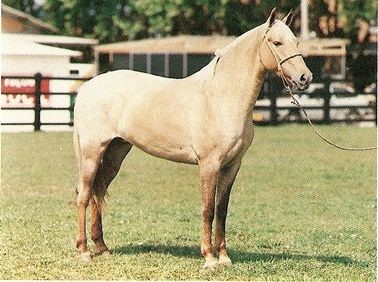 Campeiro horses originated from Spanish and Portugese horses
that were introduced into Brazil by sea Captain Alveres Nunes during his
journies from Santa Catarina to Paraguay. Their first expedition was in 1541
and Cabeza de Vaca landed with soldiers, seeds, cattle, and 46 horses. The
first official records of horses in Santa Catarina were in 1728. During the
19th century the Campeiro was crossed with Thoroughbred and Arabian blood to
refine their looks and improve performance.
Campeiro horses originated from Spanish and Portugese horses
that were introduced into Brazil by sea Captain Alveres Nunes during his
journies from Santa Catarina to Paraguay. Their first expedition was in 1541
and Cabeza de Vaca landed with soldiers, seeds, cattle, and 46 horses. The
first official records of horses in Santa Catarina were in 1728. During the
19th century the Campeiro was crossed with Thoroughbred and Arabian blood to
refine their looks and improve performance.
In 1976 the Brazilian Association of Campeiro Horse Breeders
was founded and the herd book opened in 1985.
On average they are 13.9 to 15.1 hands high. Their movement
is elastic with a marchadore and trote step, there four beat
...
|
 |
|
 Campolina Campolina
|
|
 Campolina horses originated in Brazil in 1870 when a farmer
named Cassiano Campolina bred a Brazilian mare of Barb ancestry with a pure Andalusian
stallion. Later he further refined his horses with Anglo-Norman, Clydesdale,
Holsteiner, American Saddle Horse, and Mangalarga Marchador horses.The result is the largest of the three gaited
Brazilian breeds. Their temperament is docile, but active and proud. They are
used for pleasure and trail riding, dressage, and driving.
Campolina horses originated in Brazil in 1870 when a farmer
named Cassiano Campolina bred a Brazilian mare of Barb ancestry with a pure Andalusian
stallion. Later he further refined his horses with Anglo-Norman, Clydesdale,
Holsteiner, American Saddle Horse, and Mangalarga Marchador horses.The result is the largest of the three gaited
Brazilian breeds. Their temperament is docile, but active and proud. They are
used for pleasure and trail riding, dressage, and driving.
The Campolina is a gaited breed, with an ambling gait. Their
gaits are a smooth, regular batida or a picada, the first characterized by a
longer time of movement of the bipeds in diagonal and the second only in
lateral, both with four-beat movements. T
...
|
 |
|
 Canadian Canadian
|
|
 Canadian Horses, originally called the French Canadian
Horse, was introduced to Canada in July 1665 by King Louis XIV of France.
Initially, King Louis XIV sent 12 of his best horses to reward the men who had
gone to settle "New France". France continued to import these horses,
and by 1763, their number was close to 13,000. However, as exporting the horse
continuously increased for the Boer war in Africa, plantations in the West
Indies, and to the United States for stage lines and the Civil War, by the
1860s and 1870s, there were fewer than 400 Canadian Horses with fewer than 20
registrations per year. To preserve the remaining of the breed and keep the
horse from going extinct, a stud book was produced in 1886. The decrease of
hor
...
Canadian Horses, originally called the French Canadian
Horse, was introduced to Canada in July 1665 by King Louis XIV of France.
Initially, King Louis XIV sent 12 of his best horses to reward the men who had
gone to settle "New France". France continued to import these horses,
and by 1763, their number was close to 13,000. However, as exporting the horse
continuously increased for the Boer war in Africa, plantations in the West
Indies, and to the United States for stage lines and the Civil War, by the
1860s and 1870s, there were fewer than 400 Canadian Horses with fewer than 20
registrations per year. To preserve the remaining of the breed and keep the
horse from going extinct, a stud book was produced in 1886. The decrease of
hor
...
|
 |
|
 Canadian Rustic Pony Canadian Rustic Pony
|
|
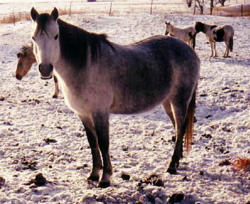 Canadian Rustic Ponies originated in Canada, particularly
the Saskatchewan and Manitoba provinces.
Canadian Rustic Ponies originated in Canada, particularly
the Saskatchewan and Manitoba provinces.
They were developed by Dr. Peter Neifeld of Manitoba,
Canada. They were developed by crossing Heck horses from the Atlanta Zoo in
Atlanta, Georgia with Arabian horse-Welsh pony crosses.
On January 23, 1989, the Canadian Rustic Pony Association
was formed, incorporated under the new Canadian federal Animal Pedigree Act,
also known as Bill C-67. Prior to this, since 1978, Canadian Rustic Ponies had
been registered through a registry based in the United States, and as of
September 1989, 72 ponies had been US-registered. These ponies were eligible to
become double-registered under the Canadian and US registries
...
|
 |
|
 Canadian Sport Canadian Sport
|
|
 The farm horse of the Canadian countryside is the base stock
for the Canadian Sport Horse. After the First World War, Thoroughbred stallions
from England were made available to cross with the countryside stock, producing
a more refined horse. In 1926, the Canadian Hunter, Saddle and Light Horse
Improvement Society was organized. In 1933, a second organization, The Canadian
Hunter Society was incorporated and a Stud Book was maintained. The two
societies merged in 1970 and renamed the society to include the term
"Sport Horse," a name which appropriately distinguishes this highly athletic
breed.
The farm horse of the Canadian countryside is the base stock
for the Canadian Sport Horse. After the First World War, Thoroughbred stallions
from England were made available to cross with the countryside stock, producing
a more refined horse. In 1926, the Canadian Hunter, Saddle and Light Horse
Improvement Society was organized. In 1933, a second organization, The Canadian
Hunter Society was incorporated and a Stud Book was maintained. The two
societies merged in 1970 and renamed the society to include the term
"Sport Horse," a name which appropriately distinguishes this highly athletic
breed.
During the First World War, and as the direct result of
Canada''s reputation for breeding quality horses, a large percentage
...
|
 |
|
 Cape Cape
|
|
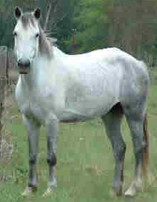 Cape horses were extremely popular through the Boer Wars,
but very little is known about the status of the Cape Horse breed today. They
originated in South Africa and greatly resembles Basuto Horses, however they
are larger.
Cape horses were extremely popular through the Boer Wars,
but very little is known about the status of the Cape Horse breed today. They
originated in South Africa and greatly resembles Basuto Horses, however they
are larger.
Horses first arrived in South African when they were imported
by the Dutch East India Trading Company in 1653. The first breeds were believed
to be Barb and Arabian descendants shipped from the Island of Java, and they
were the forefathers of both the Cape Horse and the Basuto.
Gradually, the Cape Horse was refined by introducing
Thoroughbred and Arabian blood. Through these crosses, the breed became larger
and sportier than its Basuto brethren. Despite its huge popularity as a battle
...
|
 |
|
 Carolina Marsh Tacky Carolina Marsh Tacky
|
|
 Carolina Marsh Tackys are working horses. They have an
uncanny ability to work inside water and even deep, swampy conditions along the
shoreline. They are relatively small horses (13 to 15 hands), they are ideal
for carrying around children and also for riding practices as well. They are
generally put to work on farmlands to herd cattle.
Carolina Marsh Tackys are working horses. They have an
uncanny ability to work inside water and even deep, swampy conditions along the
shoreline. They are relatively small horses (13 to 15 hands), they are ideal
for carrying around children and also for riding practices as well. They are
generally put to work on farmlands to herd cattle.
Carolina Marsh Tacky history goes back hundreds of years.
Coming from a Spanish breed of horses, the Carolina Marsh Tacky breed has more
recently been a part of the culture in South Carolina. Spanish explorers
brought theses animals over the eastern shoreline many centuries ago, as far
dating as the sixteen hundreds. Even utilized during the American Revolution,
and for workers on f
...
|
 |
|
 Carthusian Carthusian
|
|
 Carthusian (also known as Carthusian-Andalusian, and
Carthujano) horses originated in Spain. They were created when the Zamora
brothers purchased a stallion by the name of El Soldado and bred him to two
mares. A colt and a filly were produced, and the colt (a dark gray) was named
Esclavo and went on to become the foundation sire of the Carthusian breed.
Esclavo went on to produce many offspring, which were sold to breeders in
Jerez, Spain. One group of mares sired by Esclavo around 1736 were sold to Don
Pedro Picado, who then gave part of them to a group of Carthusian monks in the
settlement of a debt and sold the rest to Antonio Abad Romero where they were
absorbed into the main Andalusian breed. The stock given to the monks were
...
Carthusian (also known as Carthusian-Andalusian, and
Carthujano) horses originated in Spain. They were created when the Zamora
brothers purchased a stallion by the name of El Soldado and bred him to two
mares. A colt and a filly were produced, and the colt (a dark gray) was named
Esclavo and went on to become the foundation sire of the Carthusian breed.
Esclavo went on to produce many offspring, which were sold to breeders in
Jerez, Spain. One group of mares sired by Esclavo around 1736 were sold to Don
Pedro Picado, who then gave part of them to a group of Carthusian monks in the
settlement of a debt and sold the rest to Antonio Abad Romero where they were
absorbed into the main Andalusian breed. The stock given to the monks were
...
|
 |
|
 Caspian Caspian
|
|
 Caspian horses are small originally from Iran. Although generally
no more than 12 hands (1.22 metres) high, they are nevertheless considered to be
a horse rather than a pony.
Caspian horses are small originally from Iran. Although generally
no more than 12 hands (1.22 metres) high, they are nevertheless considered to be
a horse rather than a pony.
They are a similar build to Arabian horses, and they are extremely
hardy, with very dense bone and hard feet that rarely need shoeing. They can take
long strides and are able to keep up with normal-sized horses while walking, trotting,
or cantering, despite their smaller stature. The most common colors are bay and
black, though they may also be grey, dun, or chestnut.
Although the Caspian horse may have had a long history in its
own country it did not really become known to the rest of the world until it was
"discovered" by an American-bor
...
|
 |
|
 Castillonais Castillonais
|
|
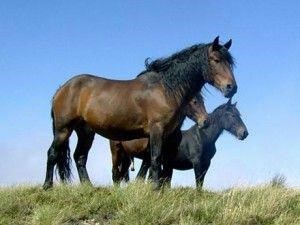 Castillonais (also known as Cheval Ariegeois de Castillon, cheval
du Biros, or Saint-Gironnais) horses are an ancient breed of small riding horse
from the Ariege departement of southwestern France.
Castillonais (also known as Cheval Ariegeois de Castillon, cheval
du Biros, or Saint-Gironnais) horses are an ancient breed of small riding horse
from the Ariege departement of southwestern France.
Castillonnais horses originally were bred for cavalry,
agriculture, and driving. They declined in population during the 20th century,
and almost became extinct. In 1980, a group of supporters began to work to save
the breed, and a breed association, now called the Association Nationale du
Cheval Castillonnais d''Ariege Pyrenees (ANCCAP), was formed in 1992. The breed
was officially recognized by the French Ministry of Agriculture in 1996. The
French government, breed association and a regional conservation group all now
share
...
|
 |
|
 Catria Catria
|
|
 Catria Horses are
from Monte Catria, Italy, and neighbouring areas (Central Appennines), spread over
the provinces of Pesaro, Ancona and Perugia.
Catria Horses are
from Monte Catria, Italy, and neighbouring areas (Central Appennines), spread over
the provinces of Pesaro, Ancona and Perugia.
Continuous contacts
with the people of Maremma in Tuscany, chiefly with those involved in charcoal-burning,
explain the introduction and the influence of the local equine population of Maremagno.
In the post-war years the herds of horses diminished considerable, but the original
population, derived from the maremmano breed, held on in mountain areas which were
only good for pasture land from wild horses.
After a period of
many crosses with various bloodlines, in 1974 the Special Co-operative Agency of
Catria took over the management of the local studs, controlling in
...
|
 |
|
 Cavallo Romano della Maremma Laziale Cavallo Romano della Maremma Laziale
|
|
 Cavallo Romano della Maremma Laziale (or "Roman horse
of the part of the Maremma that is in Lazio") are native to the Lazio
region of Italy. They are an ancient breed, but they were officially recognised
only in 2010. They are now one of the fifteen indigenous horse breeds of
limited distribution listed by the AIA, the Italian breeders'' association. The
Lazio region has assigned it the conservation status of “at risk of erosion”.
Their population numbers about 800, of which most are in the comune of Monte
Romano in the province of Viterbo; a herd of approximately 200 are at Ponzano
Romano in the province of Rome, and others are in the province of Rieti.
Cavallo Romano della Maremma Laziale (or "Roman horse
of the part of the Maremma that is in Lazio") are native to the Lazio
region of Italy. They are an ancient breed, but they were officially recognised
only in 2010. They are now one of the fifteen indigenous horse breeds of
limited distribution listed by the AIA, the Italian breeders'' association. The
Lazio region has assigned it the conservation status of “at risk of erosion”.
Their population numbers about 800, of which most are in the comune of Monte
Romano in the province of Viterbo; a herd of approximately 200 are at Ponzano
Romano in the province of Rome, and others are in the province of Rieti.
DNA testing had shown that the traditional working horse of
the Mar
...
|
 |
|
 Cayuse Pony Cayuse Pony
|
|
 The Cayuse pony, named for the Cayuse people of the Pacific Northwest, isn''t your typical pony. Despite its name, it''s a distinct breed known for its unique characteristics and historical significance.
The Cayuse pony, named for the Cayuse people of the Pacific Northwest, isn''t your typical pony. Despite its name, it''s a distinct breed known for its unique characteristics and historical significance.
Standing around 14 hands tall, these compact horses boast a stocky build with high withers and long cannon bones. This build gives them a distinctive uneven stride due to their sloped pasterns. However, don''t underestimate their agility; they navigate challenging terrain with remarkable surefootedness.
Their coats usually come in various shades of brown, showcasing a medium to large fatty hump at the shoulders. This unique feature, along with their expressive eyes and alert ears, contributes to their distinctive appea
...
|
 |
|
 Cerbat Mustangs Cerbat Mustangs
|
|
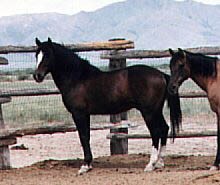 Cerbat Mustangs are beautiful and strong horses that are
used for riding or as an event horse in competitions. They have excellent
endurance and are very strong. They are smaller in size than some breeds, but
still remain durable and willing to please. They well known for their unique
ability to easily reproduce at very late ages. The Cerbat mares can still
reproduce well into their twenties, which is a great strength considering some
horse breeds only live up until they are twenty. Most of them of have a
vertebrae with five lumbar, which is also unusual.
Cerbat Mustangs are beautiful and strong horses that are
used for riding or as an event horse in competitions. They have excellent
endurance and are very strong. They are smaller in size than some breeds, but
still remain durable and willing to please. They well known for their unique
ability to easily reproduce at very late ages. The Cerbat mares can still
reproduce well into their twenties, which is a great strength considering some
horse breeds only live up until they are twenty. Most of them of have a
vertebrae with five lumbar, which is also unusual.
Cerbat horses are a part of history, much like the rest of
the Spanish routed variations. They have been commonly referred to as Spanish
Mustangs and are considered rat
...
|
 |
|
 Chahou Post Pony Chahou Post Pony
|
|
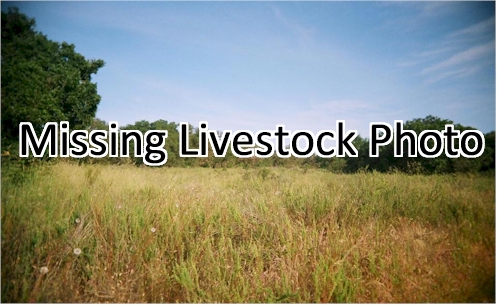 Chahou Post Ponies are from Tibetan Autonomous County of
Tianzhu, Yongding, and Gulang County, Ganshu Province, China. They are highly
resistant to disease and incredibly hardy due to their extreme habitat.
Chahou Post Ponies are from Tibetan Autonomous County of
Tianzhu, Yongding, and Gulang County, Ganshu Province, China. They are highly
resistant to disease and incredibly hardy due to their extreme habitat.
They are of moderate size (average height of 12.1 – 12.8
hands). Their back is of medium length, and they have a short girth. They are
found in black, chestnut, grey, bay, and dun.
They are known to be dependable, willing, and tough. They are
used as pack animals and for transportation.
|
 |
|
 Chaidamu Pony Chaidamu Pony
|
|
 Chaidamu Ponies are from the Qinghai Province of China.
Their numbers are very low and there is very little information available about
them.
Chaidamu Ponies are from the Qinghai Province of China.
Their numbers are very low and there is very little information available about
them.
They are moderately-sized ponies (average height 12.6 – 12.8
hands). Their Head is wide and short. Their bodies are stong and round with
short legs. They come in black, chestnut, and grey. They are known to be easy
going, sociable, and kind. They are used for riding, sports, and as draught
horses.
|
 |
|
 Chakouyi Chakouyi
|
|
 Chakouyi horses are a very little-known and ancient breed of
light horse (technically a pony) that comes from the Silk Road area of China.
Chakouyi horses are a very little-known and ancient breed of
light horse (technically a pony) that comes from the Silk Road area of China.
On average they are 12.2 – 13 hands high. Their face is
medium sized with a straight profile and large eyes. Their next is medium
length; their loin is short with well-rounded abdominal area. Their croup is
sloped and well muscled. And their legs are short with well developed joints
and little hair. They are found in black, grey, and bay. Plus often have an
elongated star on their forehead.
|
 |
|
 Cheju Ponies Cheju Ponies
|
|
 Cheju Ponies are from Cheju Island, off the southern coast
of South Korea. They are used for riding and light draft. Horses were among the
most important animals used for agriculture and military purposes from the
period of tribal states (before the first century B.C.) through the Choson
dynasty (fourteenth and nineteenth centuries).
Cheju Ponies are from Cheju Island, off the southern coast
of South Korea. They are used for riding and light draft. Horses were among the
most important animals used for agriculture and military purposes from the
period of tribal states (before the first century B.C.) through the Choson
dynasty (fourteenth and nineteenth centuries).
The Cheju native pony may have existed since prehistoric
times, although no clear record confirms this. During the Korya dynasty
(1276-1376), Mongolians governed Cheju and introduced their horses to the
island. One record shows that 160 breeding horses were brought from Mongolia to
Cheju and used for improving the native ponies. Since that time, horses raised
on Cheju have been exported
...
|
 |
|
 Chilean Corralero Chilean Corralero
|
|
 Chilean Corralero horses are related to Spanish horses that
brought to Peru by the Spanish conqueror Pedro de Valdivia in 1541. In 1557
Garcia Hurtado de Mendoza, the new governor, arrived in Chile with 42 horses of
the famous caste of the Guzmanes and Valenzuelas, marking the beginning of the
Chilean horse breed. A pure Chilean breed appeared by the beginning of the 19th
century, and the Chilean Corralero appeared by the end of the 19th century.
Chilean Corralero horses are related to Spanish horses that
brought to Peru by the Spanish conqueror Pedro de Valdivia in 1541. In 1557
Garcia Hurtado de Mendoza, the new governor, arrived in Chile with 42 horses of
the famous caste of the Guzmanes and Valenzuelas, marking the beginning of the
Chilean horse breed. A pure Chilean breed appeared by the beginning of the 19th
century, and the Chilean Corralero appeared by the end of the 19th century.
They are the oldest registered Native American breed, the
oldest registered breed of Iberian origin, the oldest registered horse breed in
South America and the oldest registered stock horse breed in the Western
Hemisphere.
First they were used by the Spanish conq
...
|
 |
|
 Chincoteague Chincoteague
|
|
 Chincoteague horses comernfrom the Eastern coast of the United States, the islands of Chincoteague and ssateague off the coast of Virginia and Maryland. They are well known forrntheir hardiness and willing to succeed. Additionally, they are raised forrnriding and harness work (they are good at carry burden long distances).
Chincoteague horses comernfrom the Eastern coast of the United States, the islands of Chincoteague and ssateague off the coast of Virginia and Maryland. They are well known forrntheir hardiness and willing to succeed. Additionally, they are raised forrnriding and harness work (they are good at carry burden long distances).
It''s not clear how thernChincoteague horses evolved, but most believe that they are related to 17 rabian horses that swam ashore from a spanish vessel that had capsized off therncoast, around 1600. Once on the islands they became stunted under the harshrnenvironment. To keep from starving they ate coarse salt marsh cordgrass, merican beachgrass, thorny greenbrier stems, bayberry twigs, seaweed and evenrnpoison ivy
...
|
 |
|
 Choctaw Choctaw
|
|
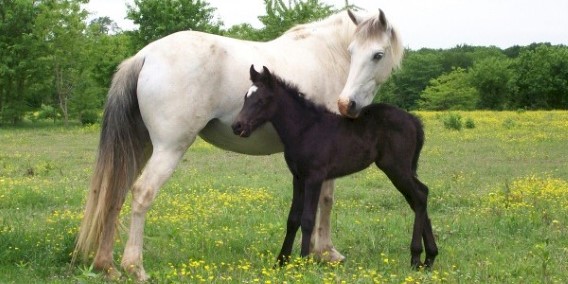 Choctaw horses are the direct descendants of horses that
traveled with the Choctaw Indians on the "Trail of Tears" in the
1830s from the southeast U.S. to the reservations in Oklahoma.
Choctaw horses are the direct descendants of horses that
traveled with the Choctaw Indians on the "Trail of Tears" in the
1830s from the southeast U.S. to the reservations in Oklahoma.
The Trail of Tears was a series of forced removals of Native
American nations from their ancestral homelands in the Southeastern US to an
area west of the Mississippi River that had been designated as Indian
Territory. The forced relocations were carried out by various government
authorities following the passage of the Indian Removal Act in 1830. The
relocated people suffered from exposure, disease, and starvation while en
route, and more than four thousand died before reaching their various
destinations. The removal included members of
...
|
 |
|
 Cleveland Bay Cleveland Bay
|
|
 Cleveland Bay horses originated in England during the 17th
century, named after its coloring and the Cleveland district of Yorkshire. They
are the oldest established horse breed in England, and the only non-draught
horse developed in Great Britain.
Cleveland Bay horses originated in England during the 17th
century, named after its coloring and the Cleveland district of Yorkshire. They
are the oldest established horse breed in England, and the only non-draught
horse developed in Great Britain.
Cleveland Bay horses are well-muscled, with legs that are
strong but short in relation to the body. They are always bay in colored,
although a few light hairs in the mane and tail are characteristic of some
breed lines.
In the middle ages in the north east of England bay colored
horses were bred for pack work, which was the preferred way of transport of the
travelling salesmen, often referred to as chapmen. So these horses were called
Chapman horses. In t
...
|
 |
|
 Clydesdales Clydesdales
|
|
 Clydesdales are
large draught horses derived from farm horses of Clydesdale, Scotland. They were developed by the farmers of Lanarkshire,
through which the River Clyde flows. The old name for Lanarkshire is Clydesdale.
They were originally used for agriculture
and hauling, and they still are used for draught purposes today. They have also
been used to create and improve other draught breeds.
Clydesdales are
large draught horses derived from farm horses of Clydesdale, Scotland. They were developed by the farmers of Lanarkshire,
through which the River Clyde flows. The old name for Lanarkshire is Clydesdale.
They were originally used for agriculture
and hauling, and they still are used for draught purposes today. They have also
been used to create and improve other draught breeds.
They were bred to meet not only the agricultural
needs of these farmers, but the demands of commerce for the coal fields of Lanarkshire
and for all the types of heavy haulage on the streets of Glasgow. The breed soon
acquired more than a local reputation, and in time, the breed spread throughout
the whole of Scotland and northern Eng
...
|
 |
|
 Colonial Spanish Colonial Spanish
|
|
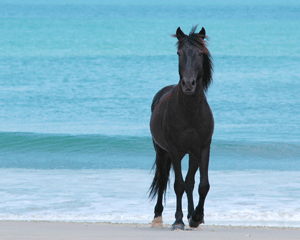 Colonial Spanish horses were at one point very popular and
were prized by Spanish explorers in the fifteenth century. They were brought to
America by explorers, and were allowed to roam. Later they became popular in
the western states and were cross bred to create a larger animal. However; by
the mid-nineteen hundreds, they were thought to be extinct. A man named Robert
E. Brislawn developed the Spanish Mustang Registry and the entire breed was
saved from that point on.
Colonial Spanish horses were at one point very popular and
were prized by Spanish explorers in the fifteenth century. They were brought to
America by explorers, and were allowed to roam. Later they became popular in
the western states and were cross bred to create a larger animal. However; by
the mid-nineteen hundreds, they were thought to be extinct. A man named Robert
E. Brislawn developed the Spanish Mustang Registry and the entire breed was
saved from that point on.
Currently, there are a few thousand horses registered with
the Spanish Mustang registry. Historically, they have been known to have the
ability to travel very far and not sustain any health ailments at all, which is
quite remarkable. In their native Spain
...
|
 |
|
 Colorado Ranger Colorado Ranger
|
|
 Colorado Ranger horses are from the Colorado High Plains in
the United States. They are descended from two stallions imported from Turkey
to Virginia, US, in the late 1800s. These stallions were then bred to ranch
horses in Nebraska and Colorado, and in the early 1900s the two stallions who
every registered Colorado Ranger traces to, Patches #1 and Max #2, were foaled.
The breed was championed by rancher Mike Ruby, who founded the Colorado Ranger
Horse Association in 1935.
Colorado Ranger horses are from the Colorado High Plains in
the United States. They are descended from two stallions imported from Turkey
to Virginia, US, in the late 1800s. These stallions were then bred to ranch
horses in Nebraska and Colorado, and in the early 1900s the two stallions who
every registered Colorado Ranger traces to, Patches #1 and Max #2, were foaled.
The breed was championed by rancher Mike Ruby, who founded the Colorado Ranger
Horse Association in 1935.
By 2005, more than 6,000 Colorado Ranger horses had been registered.
Colorado Rangers may be any solid color or carry leopard spotting patterns.
Pinto coloration and American Paint Horse breeding are not allowed, nor are
draft horse and pony breed
...
|
 |
|
 Comtois Comtois
|
|
 Comtois horses are draft horse that originated in the Jura
Mountains on the border between France and Switzerland. It is believed to they
descended from horses brought by the Burgundians of northern Germany to France
during the fourth century. In the Middle Ages they were used as war horses. In
the 19th century, other draft horses such as the Norman, Boulonnais, and
Percheron horses were bred with Comtois horses, and more recently Ardennes
horses were used to produce a stronger horse with better legs. Today, they are
second only to the Belgian draft horse in number in France.
Comtois horses are draft horse that originated in the Jura
Mountains on the border between France and Switzerland. It is believed to they
descended from horses brought by the Burgundians of northern Germany to France
during the fourth century. In the Middle Ages they were used as war horses. In
the 19th century, other draft horses such as the Norman, Boulonnais, and
Percheron horses were bred with Comtois horses, and more recently Ardennes
horses were used to produce a stronger horse with better legs. Today, they are
second only to the Belgian draft horse in number in France.
|
 |
|
 Connemara Connemara
|
|
 Connemara Ponies are Ireland’s native pony originally from Galway.
Their popularity is extensive worldwide. They are a historic breed that is considered
to be “sure footed and hardy”. Connemara ponies have a calm temperament, staying
power, intelligence, soundness, and athleticism. They are considered to be a wonderful
modern riding mount for children and adults alike.
Connemara Ponies are Ireland’s native pony originally from Galway.
Their popularity is extensive worldwide. They are a historic breed that is considered
to be “sure footed and hardy”. Connemara ponies have a calm temperament, staying
power, intelligence, soundness, and athleticism. They are considered to be a wonderful
modern riding mount for children and adults alike.
The exact origins of Connemara Ponies are difficult to decipher
and are immersed in myth and fable.The general
consensus is that the history of the breed started with the arrival of the Celts
in Ireland. The Celts traveled across Northern Europe, through England, Scotland,
and Wales, arriving eventually on the West Coast of Ireland over 2,500 years ago.
,
...
|
 |
|
 Corsican Corsican
|
|
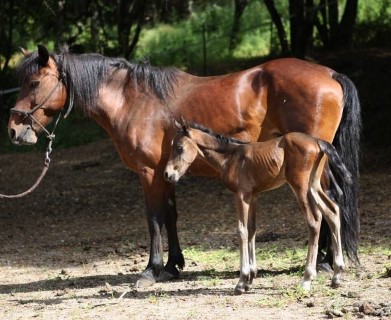 Corsican (also known as U Cavallu Corsu or u paganacciu or Cheval corse) horses are small horses indigenous to the Mediterranean island of Corsica, off the coast of south-eastern France.
Corsican (also known as U Cavallu Corsu or u paganacciu or Cheval corse) horses are small horses indigenous to the Mediterranean island of Corsica, off the coast of south-eastern France.
There are no equines in the fossil record of Corsica, and for that reason it is believed that humans brought the first horses to the island, along with a number of other animals. The Haras Nationaux set up a remount depot on the island in 1861 for the purpose of producing light cavalry horses and mules. When the military ceased to breed horses there, the animals remaining were bred by local people and reverted to a homogeneous phenotype due to what essentially became natural selection.
Corsican horses are small, standing between 1.30
...
|
 |
|
 Costa Rican Costa Rican
|
|
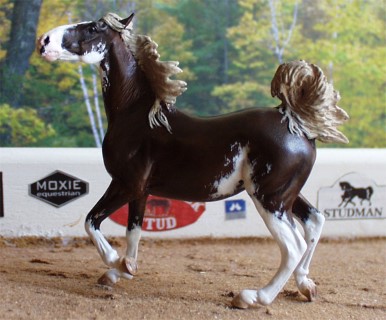 Since 1850 breeders of the Costa Rican horse have paid morernattention to the selection of breeding stock. Because the horse population wasrnsmall and inbreeding became a concern, a few stallions were imported from Spainrnand Peru. The result is the Costa Rican saddle horse.
Since 1850 breeders of the Costa Rican horse have paid morernattention to the selection of breeding stock. Because the horse population wasrnsmall and inbreeding became a concern, a few stallions were imported from Spainrnand Peru. The result is the Costa Rican saddle horse.
The breed was founded by Janitzio, foaled inrn1955, a loudly marked sabino stallion. In 1972 a breed club (ASCACOPA) wasrnestablished, and in 1974 the breed registry was initiated.
The minimum height for males is 14.2 1/2 hands (148 centimetres 58 in)) and 14.1 1/2 hands (146 centimetres (57 in)) for females. Their headrnprofile is straight or slightly convex. Their neck is arched, ample at the basernand tapered toward the head. Their chest is deep and w
...
|
 |
|
 Criollo Criollo
|
|
 Criollo horses are native of Uruguay, Argentina, Brazil, and
Paraguay. They may have the best endurance of any horse breed in the world next
to Arabian horses. In fact, due to a low basal metabolism, they may be a better
long-distance horse than Arabians in prolonged races over a week in duration
with no supplemental feed. Because of their hardiness and stamina they are very
popular in its home countries.
Criollo horses are native of Uruguay, Argentina, Brazil, and
Paraguay. They may have the best endurance of any horse breed in the world next
to Arabian horses. In fact, due to a low basal metabolism, they may be a better
long-distance horse than Arabians in prolonged races over a week in duration
with no supplemental feed. Because of their hardiness and stamina they are very
popular in its home countries.
The word criollo originally referred to human and animals of
pure-bred Spanish ancestry that were born in the Americas, or, in Portuguese
crioulo, to animals or slaves born in the Americas. In time, the meaning of the
word would simply come to refer to native breeds of the Americas.
Criollo bloodlines co
...
|
 |
|
 Croatian Coldblood Croatian Coldblood
|
|
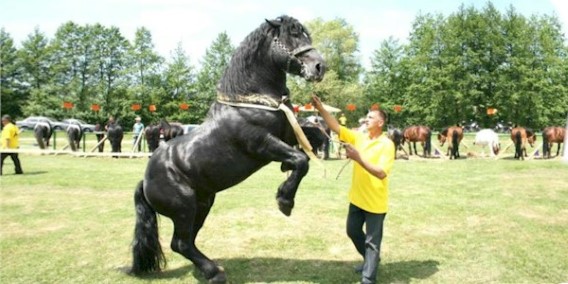 Croatian Coldblood (Croatian: Hrvatski hladnokrvnjak,
German: Kroatisches Kaltblut) horses are medium-heavy draught horses developed
in Croatia.
Croatian Coldblood (Croatian: Hrvatski hladnokrvnjak,
German: Kroatisches Kaltblut) horses are medium-heavy draught horses developed
in Croatia.
The history of the breed dates back to the first half of the
19th century, when it was begun to crossbreed local warmblood mares in central
Croatia with imported quality stallions of Noriker breed. Some other breeds
were involved later, like Ardennes, Brabant, and Percheron. At the beginning of
the 20th century the breed was widespread toward east (Slavonia) and west
(Gorski kotar and Istria regions).
The typical Croatian Coldblood ranges from 150 centimetres
(14.3 hands; 59 in) to 160 cm (15.3 h; 63 in) high. Stallions can weigh up to
850 kilograms (1,870 lb). Its head i
...
|
 |
|
 Cuban Paso Cuban Paso
|
|
 Cuban Paso (or Cubano de Paso) horses originated from
Spanish horses brought to the new world by conquistadors. They are best known
for their elegant and comfortable pace. They are a strong but elegant horse
used for transportation in Cuba.
Cuban Paso (or Cubano de Paso) horses originated from
Spanish horses brought to the new world by conquistadors. They are best known
for their elegant and comfortable pace. They are a strong but elegant horse
used for transportation in Cuba.
Their head is proportional to their body with a straight
profile which at times can be slightly convex or concave. Their forehead is
wide, their ears are medium sized and mobile. They have a strong neck and high,
oblique muscular croup and a straight and strong back. Their tendons and joints
are well defined. Their legs are strong and structured. Their average height
lies between 1.45 and 1.50 m. Their most frequent color is brown although every
color is found.
...
|
 |
|
 Cuban Pintos Cuban Pintos
|
|
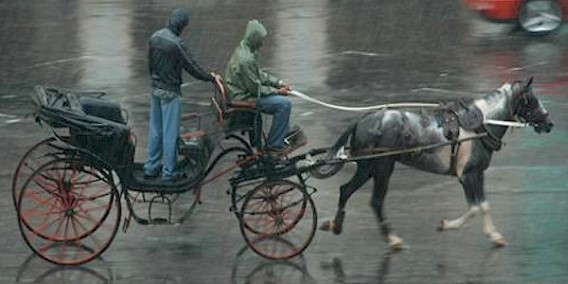 Cuban Pintos (or Pinto Cubano) horses originated from
Spanish horses brought to the South America by conquistadors. After the Cuban
revolution in 1959 a herd of pinto mares was gathered in the area around Manicaragua,
in the Cuban province of Santa Clara, for their genetic improvement. Afterwards
on the ranch La Guabina, located in the province Pinar del Rio, their muscular
development was improved interbreeding them with Quarter horses and a British
pinto horse called Bony.
Cuban Pintos (or Pinto Cubano) horses originated from
Spanish horses brought to the South America by conquistadors. After the Cuban
revolution in 1959 a herd of pinto mares was gathered in the area around Manicaragua,
in the Cuban province of Santa Clara, for their genetic improvement. Afterwards
on the ranch La Guabina, located in the province Pinar del Rio, their muscular
development was improved interbreeding them with Quarter horses and a British
pinto horse called Bony.
They are found in only tobiano and overo. Their average
height lies between 1.44 and 1.52 m, their head is proportional to their body
with a straight or slightly convex profile and medium sized or small ears. Their
neck is quite long and well a
...
|
 |
|
 Cumberland Cumberland
|
|
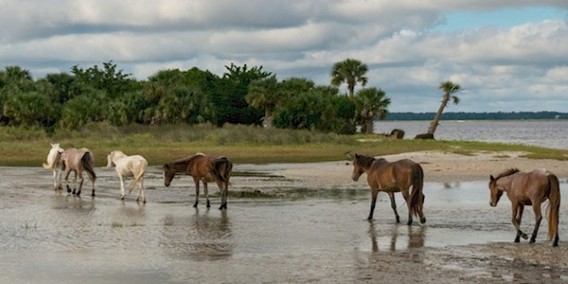 Cumberland Island (a barrier island off the state of
Georgia’s, US, southeast coast )is one of a handful of places on the East Coast
that are home to bands of feral horses. The horses on Cumberland Island may
have similar ancestors to the Chincoteague/Assateague ponies, which are thought
to have been either shipwrecked or abandoned there by Spanish explorers in the
1500s.
Cumberland Island (a barrier island off the state of
Georgia’s, US, southeast coast )is one of a handful of places on the East Coast
that are home to bands of feral horses. The horses on Cumberland Island may
have similar ancestors to the Chincoteague/Assateague ponies, which are thought
to have been either shipwrecked or abandoned there by Spanish explorers in the
1500s.
Plantation owners, various military activities, and influxes
of pleasure horses brought by the island''s more recent residents blended into
the population over the centuries, resulting in a horse that''s still very
tough, but not as stubby and fuzzy as its cousins to the North. It''s not
unusual for the Cumberland horses to reach 15 hands (5 feet t
...
|
 |
|
 Curly Curly
|
|
 Forget straight and sleek, the Curly horse flaunts a unique coat of ringlets that cascade down their body like a living sculpture. This captivating breed, hailing from North America, isn''t just admired for its distinctive curls, but also for its hardy spirit, calm temperament, and adaptability.
Forget straight and sleek, the Curly horse flaunts a unique coat of ringlets that cascade down their body like a living sculpture. This captivating breed, hailing from North America, isn''t just admired for its distinctive curls, but also for its hardy spirit, calm temperament, and adaptability.
Imagine a medium-sized horse, sturdy and strong, with a coat that ranges from tight curls resembling crushed velvet to gentle waves. They come in all colors, from chestnut and bay to appaloosa and pinto, offering a visual feast like a living kaleidoscope. Even their eyelashes curl upwards, adding to their whimsical charm.
But beauty isn''t everything. Curly horses boast a gentle and intelligent nature, making them easy to train
...
|
 |
|
 Czech Warmblood Czech Warmblood
|
|
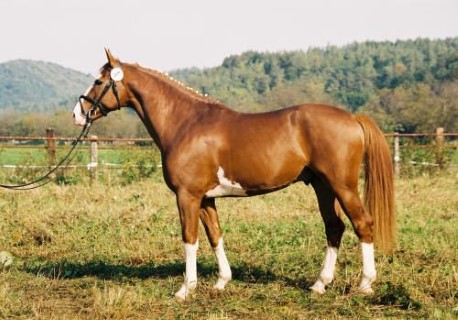 Czech Warmblood (Czech: Cesky Teplokrevnik) horses are warmblooded
sport horse from the Czech Republic. They were in existence by the time of the
Austro-Hungarian Empire (1876-1918). In the 19th century they were influenced
by Spanish and Italian horses, and later by breeds such as Furioso, Gidran,
Nonius, and Przedswit horses.
Czech Warmblood (Czech: Cesky Teplokrevnik) horses are warmblooded
sport horse from the Czech Republic. They were in existence by the time of the
Austro-Hungarian Empire (1876-1918). In the 19th century they were influenced
by Spanish and Italian horses, and later by breeds such as Furioso, Gidran,
Nonius, and Przedswit horses.
Czech Warmblood horses are robust, powerful horses with
strong bones. They have a strong neck on an elegant body, a broad, long back
and good hooves, though they are sometimes flat. Their mane and tail are very
thick. They are also relatively long-lived, unpretentious and relentless horses.
They are willing and teachable with a very good temperament. Most are black,
chestnut, bay, or dark bay
...
|
 |


